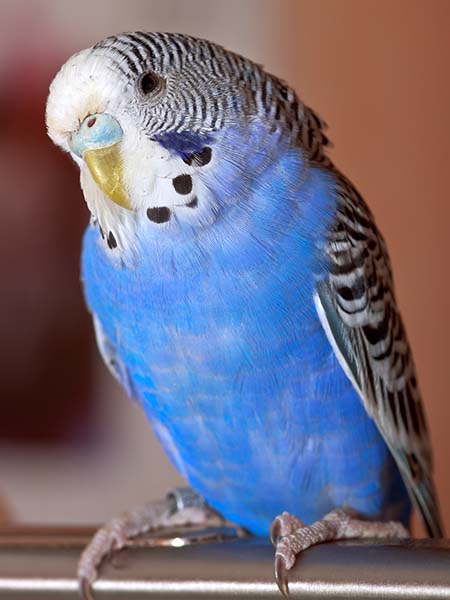
This is one of the most common colors of parakeet, green and yellow. The coloring is common in budgies. Note the blueish purple around the “cheeks” of the bird.
Parakeet Colors
Parakeets, particularly the popular budgerigar (budgie), come in a wide variety of colors. The natural coloration of wild budgerigars is light green with black stripes and a yellow face, but selective breeding has produced many different colors and patterns.
Common Color Variations in Parakeets
Here are some common color variations:
- Green Series – Includes shades from light yellow-green to dark green.
- Blue Series – Ranges from sky blue to deep cobalt.
- Grey – From light to dark grey, often combined with other colors.
- White (Albino) – Pure white with red or pink eyes.
- Yellow (Lutino) – Bright yellow with red or pink eyes.
- Pied – A mix of any of the above colors with patches of clear or white.
- Opaline – A color pattern that changes the typical markings.
- Violet – A deep, vibrant purple, often mixed with blue.
- Cinnamon – A softer version of the bird’s natural color, with a brownish tinge.
These variations may appear in different combinations, producing an even broader spectrum of appearances in pet parakeets.
How many parakeet colors are there?
The exact number of recognized color variations for parakeets can vary depending on the breed and the standards set by different bird enthusiasts’ groups. For budgerigars, commonly known as budgies, there are generally around 30 recognized color mutations, but this number can fluctuate slightly with the recognition of new mutations or reclassifications.
Common Parakeet Colors
Green & Yellow
Blue & White
Yellow
White

The diversity in parakeet colors is primarily due to a combination of genetic factors, pigmentation, and selective breeding. Here’s an explanation of what contributes to their vibrant and varied hues:
1. Pigmentation
- Melanin: Responsible for darker colors such as black, brown, and gray. Melanin concentration and distribution affect the intensity of these shades.
- Psittacofulvins: Unique to parrots, these pigments produce yellow, red, and orange hues. Psittacofulvins are synthesized within the feathers and are not diet-dependent, unlike the carotenoids found in some other birds.
2. Structural Colors
Parakeet blues and greens are created through structural coloration, where microscopic structures in their feathers scatter light to reflect specific wavelengths:
- Blue Feathers: Occur when structural properties reflect blue light, while other colors are absorbed.
- Green Feathers: Result from a combination of yellow psittacofulvins and the structural blue reflection.
3. Genetic Variations
Genetic mutations influence color diversity by altering the production or distribution of pigments and structural feather properties:
- Recessive Mutations: Such as those producing albino or lutino parakeets (lacking melanin but retaining psittacofulvins).
- Dilution Genes: Lessen the intensity of colors, creating pastel shades.
- Color-Specific Mutations: Lead to unique hues like opaline, spangle, or pied patterns.
4. Selective Breeding
In captivity, selective breeding has significantly expanded the color range of parakeets:
- Breeders pair birds with specific genetic traits to enhance or combine desirable colors and patterns.
- This practice has led to rare combinations, such as violet, cobalt, and rainbow parakeets.
5. Environmental Factors
While most colors are genetically determined, some environmental factors can influence feather condition, such as:
- Diet: A healthy diet supports vibrant feather coloration, although it does not create new colors in parakeets.
- Lighting: Proper exposure to natural or UV light ensures pigments develop and maintain their full brilliance.
Parakeet colors are a fascinating interplay of biology and genetics, enriched by human involvement through breeding programs. This diversity makes them one of the most visually captivating pet birds.
What are all of the Parakeet Colors?
- Green
- Blue
- Grey
- White (Albino)
- Yellow (Lutino)
- Pied
- Opaline
- Violet
- Cinnamon
- Clearwing
- Spangle
- Fallow
- Lacewing
- Dilute
- Dark-eyed Clear
- Dominant Grey
- Greywing
- Saddleback
- Silver
- Cream
- Cobalt
- Mauve
- Olive
- Turquoise
- Clearflight
- Goldenface
- Texas Clearbody
- Anthracite
- Yellowface
- Double Factor Spangle
- Blackface